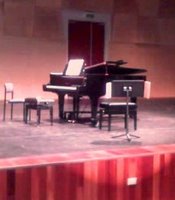
My partner took me to a cello recital on Saturday at the Canberra Girls Grammar School (nice auditorium!). The Japanese cellist, Tsuyoshi Tsutsumi played with Susanne Powell on piano. I found the experience to be a wonderful journey through history, culture and Tsutsumi's amazing repertoire! The audience was so appreciative that they played two encore pieces!
My partner and I talked afterwards over a glass or two of the good stuff, about how we experienced the evening. My partner said he'd caught himself 'thinking' during the recital, that is thinking about the mechanics, processes and techniques of the music played. He also wondered about how he was 'feeling' the performance. He was trying to work out how thinking and feeling were working together, if at all (it figures, as he's doing his PhD on embodied experiences!). He asked whether or not thinking and feeling were mutually exclusive, or whether they were part of the same continuum. Are they different concepts? ...all good questions!
For me, I noticed that I was physically - bodily - engaged in the performance to the point where I could feel my ears working! My whole body was attentive to the music, alert and receptive.
I am not an auditory learner, in fact I am predominantly visual-kinesthetic. I rely more heavily on my visual capacity to take in and convey information. In addition, I tend to support my visual preferences with kinesthetic forms, so I feel I am 'doing' something with the information I see (that is take a photo, write a note about what I see, etc). So, it was very much a novelty for me to exercise my ears and remain in full awareness of my embodied experience of the evening.
I still couldn't help conjuring up visual metaphors though! For instance, the melody of one particular movement left me with the image of a piece of paper lightly floating down through the air, drifting side to side as it falls. Another piece, a solo by Tsutsumi, conjured up the image of a spray of water shot into the air followed by the lingering mist of droplets that trail away - the lingering notes and spaces created in their resonance! Just beautiful!
It really made me think about the learning styles I so often push in my workshops, you know, 'is there a predominant style of learning in your student group?' Are they visual or auditory learners? Perhaps they are hands-on kinesthetic learners?...that sort of thing. It made me think about what it really means to talk about styles of learning. My cello experience helped me to dwell more on it, to sit with it longer. It helped create a space both the feel and to think, and to reflect on my feelings and thoughts, without a need to rush to a rational conclusion.
More, I thought about the definitive style of Tsutsumi's cello-playing and that it could be considered his fingerprint - no one else in the world plays like him! So too, each of us as learners are 'fingerprints'! Perhaps we need to work on fostering supportive emotional-reflective learning spaces instead of simply rationalising a learning 'environment' to be the range of 'tools' our learners might use in their learning.
IMHO, learners have all the 'tools' they need for their learning within them. The trick to teaching and to educational design is to encourage learners to realise their tools and work more ably with them. As one of my dear colleagues once said - discover the 'inner learner' and then give voice to that role!
Is learning about changing people's lives?
How do we know when we have learnt things?
What occurs in the learning moment?
What turns us on for learning?
And what the heck is learning anyway?
...Is there a need to revolutionise learning and our education systems?
I'm dwelling on these questions (and more) at the moment and considering Peter's questions at Learning Circuits too...
So what’s the point of all this? I’m suggesting that we may have a tendency to paint ourselves into linguistically and culturally determined corners that restrict our reflection on the very problems we all recognize. Perhaps we need a bit of lateral thinking rather than head-on debate, or rather, we need both, as they are the yin and yang of inquiry. Instead of looking for a winner between polar opposites let’s try to see what both doing and non-doing accomplish and how formal and informal complement each other. Is that beyond our powers?
Join the thinking about learning (...or is it feeling!)....!
[cello], [auditory], [audio], [senses], [learning styles]
No comments:
Post a Comment